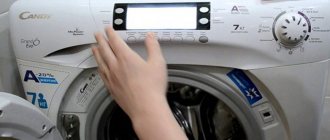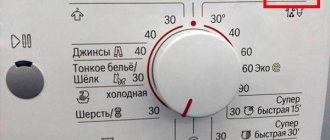The washing cycle takes a certain time, as provided by the program (usually from half an hour to three hours maximum). If you notice that your washing machine is washing much longer than expected, do not ignore it. Extension of the work cycle can be caused by a variety of reasons. To avoid major breakdowns, you should call a technician and have a professional diagnosis done.
Our masters often encounter situations where clients complain about very long washing. Failures can occur both when turning on individual programs and in general. The washing cycle is extended indefinitely, and sometimes the unit continues to operate until disconnected from the power supply.
Among the most common reasons for lengthening the work process:
- Water supply problem
This problem occurs when there is poor water pressure in the water supply system, the tap is not fully open, the filter is dirty, or the water supply valve malfunctions. In the latter case, the intake valve needs to be replaced.
- Problems with drainage
They occur when the filter, pipes, and drain hose become clogged. In this case, the machine takes longer to drain the water, and the whole process is accordingly lengthened. You can clean the filter yourself, but it is better to entrust cleaning of the pipes to a specialist.
- Water does not stay in the machine
If the pressure switch breaks down, the water circulates endlessly, and the cycle lengthens due to the continuous addition and drainage of water. Also, sometimes the washing machine takes a very long time to wash due to improper connection. This usually happens when installing the unit yourself. In this case, the water leaves by gravity, and the washing process, in fact, does not begin. The problem is resolved by correct connection.
- Malfunctions of the heating element
The heating element begins to act up if a large amount of scale forms on it. As a result, thermal conductivity decreases, water takes longer to heat up, and washing time increases. In these cases, cleaning the heating element from scale will correct the situation. You can try to remove the scale yourself, but this is usually ineffective.
If the heating element is completely damaged, it will need to be replaced. Some models of washing machines with such a breakdown simply “freeze” for a while and subsequently continue washing in cold water, others completely stop the cycle and display the corresponding error.
- Thermostat failure
When the temperature sensor does not detect the temperature correctly, the heating time increases and the wash takes longer. Sometimes “variable failures” are observed when one time the temperature is determined correctly, and during the next wash the information about the water temperature is again distorted. The problem is resolved by replacing the thermostat.
- Malfunctions of the electronic module or programmer
This reason may be indicated by the machine freezing during the operating cycle, resulting in longer washing times. Diagnostics of the control system and flashing or replacement of the control board are required.
Before seeking professional help, check whether the filter is clogged and the position of the inlet and drain hoses. Straighten them if there are kinks and clean the filter. Check to see if the water supply valve is fully open - this may also be the cause of the wash taking too long. Disconnect and reconnect the drain hose to the sewer coupling.
If there was too much laundry in the stack, repeat the wash with the optimal weight recommended by the instructions (the average between the minimum and maximum weight). Sometimes following the operating rules is enough to make the problem disappear. But, as practice shows, more often than not, any malfunctions of washing machines lead to prolongation of the cycle. Do not try to fix them yourself, as this can lead to major damage. Calling our technician is a guarantee that the washing machine will be returned to working condition as soon as possible, and you will be able to save on expensive repairs. Always use professional help, even if the breakdown is minor (for example, the UBL is broken). This is the only way to extend the life of your assistant without having to repair the washing machine.
Depending on the mode, washing can last from 15-30 minutes to 1-2.5 hours. It is also normal that the washing machine does not turn off 5 minutes after the start of washing. But when you set a program for 30 minutes, and the washing machine continues the process for more than 2 hours, this is not normal. In this situation, it is important to understand why the washing machine continues to wash much longer than it should according to the regime. In this article, we examined the eight most common reasons.
Fault table
| Symptoms of malfunction | Possible reason |
| The washing machine takes a long time to distribute the laundry through the drum, which increases the washing time | In this case there are no breakdowns - this is an overload of the drum. You just need to take out the excess laundry |
| It takes a long time for water to fill the washing machine, which causes the washing time to decrease significantly | 1. The valve on the water supply hose is not fully open, or the hose is squashed somewhere. |
What could cause the malfunction?
Usually, if the washing machine suddenly stops during washing, then after some time an error code is displayed on the display, by which we can determine what kind of malfunction we are dealing with. This happens in 90% of cases, but even if we find out what malfunction caused the stop, we will still have to think about how to solve the problem, because the washing machine itself will not fix itself.
First, you need to understand the typical causes of malfunctions that cause the machine to suddenly stop during washing. Then you will need to move on to studying the nuances of these faults and methods for eliminating them. Let's start with typical breakdowns.
- You put too much laundry in the drum or put it in the wrong way.
- The user has selected the wrong washing mode.
- There were problems with the washing machine's electrical system (sensors, wires, terminals).
- There are problems with the electronic control unit of the washing machine.
- The leakage protection system has been activated.
- The hatch door does not lock properly or suddenly unlocks.
- There is a serious breakdown of the most important components of the machine: the engine, heating element or drain pump.
Note! In addition to the above breakdowns, problems sometimes arise with filler and drain valves. If the machine cannot fill or drain water normally, this in some cases can also cause the washing to stop.
Washing machine overload
If you put more laundry in the drum than is written in the instructions, then it will be very difficult for your unit to distribute it evenly and gain the required speed, while the machine will constantly make a constant effort, and the housewife will feel like the laundry is being washed, but very slowly. Laundry stacked in a lump can also cause prolonged distribution on the drum.
The problem can be solved simply - try running the wash with less laundry.
See also -
Electrolux washing machine displays error E40 - what does it mean?
Useful tips for housewives
In order for the washing to take place at the time set by the mode and the machine to work smoothly, you must:
- Periodically, the user should prevent the formation of scale and plaque. For this purpose, specialized tools for machines are used. Folk remedies based on citric acid and vinegar are suitable.
- Housewives also need to ensure that blockages do not form in different parts of the equipment.
- It is preferable to use quality products.
- Do not use powder for hand washing; use those marked “for machine wash”.
- Wash items with decorative elements (buttons, rhinestones, stones) and shoes only in special covers.
Among the frequently asked questions regarding long washing is whether it can be used in such a situation. If the device works and the electronics do not generate an error, then the situation is regarded as relatively acceptable. It is important to understand here that the equipment operates at an increased rate, in other words, for wear and tear. Machine parts are subject to heavy loads. The second important point is increased energy consumption. To extend the life of your washer, prevent major repairs and save money, it is important to recognize the problem in time and solve it.
The reasons why a machine takes a long time to wash can be external and internal. External ones can be eliminated independently. Internal problems can be resolved by a service center specialist. It is important not to delay the situation so that the washing machine does not break down.
Problems with water supply
The wash does not start because the washer is unable to collect the required amount of liquid. The process takes longer. There are several reasons why this problem may occur:
- There is low pressure in the water supply pipes. If this is the case, then washing should be postponed for a while until the pressure is normal;
- The taps are not fully open. You just need to check and fully open the tap that goes to the washing machine;
- the filter mesh on the inlet valve is very clogged. In this case, it is necessary to clean the filter or replace it with a new one;
- The water inlet valve has failed and will have to be replaced.
Features of the problem
A washing machine is a rather complex unit. It works according to a clear scheme, which is established by the program. To understand the situation more clearly, it is necessary to determine all the specifics of how this technique works. The user selects the program he needs, then the washing machine executes the command and monitors the process. If any deviation from the set parameters occurs, the electronic unit determines the failure of any program. Washing time increases.
The washing period takes from 30 minutes to 2 hours and depends on the selected program. It may often mistakenly seem that the process has taken a long time. First of all, you need to make sure that you have selected a standard program that does not require additional soaking and rinsing. In order to be completely sure that the equipment is faulty, you need to run some program and observe. This tactic will allow you to understand at what stage the malfunction appeared.
Note! In addition to the fact that the machine washes for longer than the stated time, the transition to rinsing and spinning may not occur.
Slowly drains water (stuck on drain)
The washing process may take longer if the water drains from the machine very slowly. This may cause long washing times. We check the nodes and elements of the drain:
- we check and clean the drain filter, which is located at the bottom of the front panel of the washing machine, read how to drain the water from the washing machine.
- check whether the impeller is spinning;
- clean the pipe that is attached to the pump. Disconnect the washing machine from the electricity and turn off the water. Carefully place it on its side so that the drain pump is accessible. Then we loosen the pipe clamp; if there is a blockage, we clean it and install it back;
- We check the drain hose, perhaps it is clogged. Clean it or install a new one.
See also -
Why do all the indicators on the Indesit washing machine blink?
Constantly collects and drains water: the washing process does not start
If there is good pressure in the system, you have cleaned all the filters and the pump is running, but water is drawn in and immediately leaves, there are two reasons for this:
The washing machine is not connected correctly
If the connection to the drain is incorrect, the following happens - water accumulates to a certain level and begins to go into the sewer. As a result, the required amount of liquid does not enter the machine - the wash does not start. You need to raise the hose 60 cm from the floor. Many models have a mount on the back wall into which the hose snaps into place. Check the position of the drain hose relative to the level of the washing machine.
The pressure switch is faulty
Pressostat is a sensor indicating the water level. His task is to give a command to the machine that it is time to start washing when there is enough water in the tank. If it fails, then the unit does not understand whether enough fluid has accumulated or whether it is there at all. The process will be endless - if the tank is full, water flows into the sewer, and the machine will begin to draw water again. This problem can be corrected by simply replacing the water level sensor.
Intake valve malfunctions
With this breakdown, the valve may work intermittently - not open completely, or even freeze. The problem can be solved by replacing it with a new one.
The pressure switch is broken
A common reason why an automatic machine will take a long time to wash is considered to be a malfunction of the water level sensor. A failed pressure switch does not give a command to the control center that the level has been accumulated enough for washing, which is why an automatic reset of the accumulated volume is triggered, followed by the addition of the next portion. In this case, the part must be replaced.
Sometimes the breakdown may be caused by a malfunction of the inlet valve, which does not close completely when water is supplied, which leads to the entry of excess liquid. For this reason, a full wash in a given time mode is not possible. The intake valve will have to be replaced.
Problem with the control module or programmer (the drum spins for a long time or freezes)
If the control module fails, the machine begins to set programs incorrectly, or turns them on one after another, or simply does not turn on. In this case, the washing continues indefinitely or stops right in the middle of the process. You won't be able to solve this problem on your own. Only a specialist will be able to determine whether the module can be repaired; it may require a complete replacement.
What happened to the machine?
This “symptoms” is very vague; it is impossible to immediately identify one exact cause of the breakdown. However, by analyzing the situation, you can narrow down the range of possible problems in the operation of the equipment. Long operation of the washing machine may be due to:
- drum overload. It would seem, what does the maximum permissible weight of laundry have to do with it? The fact is that the washing machine spends more time distributing the laundry over the surface of the drum, as a result of which the cycle is lengthened. Solving the problem is very simple - take out unnecessary things;
- problem with filling water into the tank. The washing time can increase significantly if the machine takes a long time to fill with water. The reason for this may be a clogged filter or inlet hose, or a defective inlet valve. Perhaps the valve that shuts off the water is not fully open;
- long drain. It takes several minutes to remove the waste liquid from the tank. When starting a standard cycle, water is drained from the system at least 3-4 times. Therefore, if you add another 5-10 minutes to each drain, the program execution time will increase noticeably. Water may have difficulty leaving the drum due to a clogged drain hose, garbage filter, or pump;
- malfunction of the heating element or temperature sensor. In this case, the water takes much longer to warm up to the desired temperature, resulting in longer program execution times. It is possible that a lot of scale has accumulated on the heating element, as a result of which its performance has decreased. The problem may also lie in a faulty thermistor that incorrectly records the heating temperature of the liquid;
- damage to the main control unit. The main “symptom” of such a breakdown is that the machine begins to “freeze” during the washing process, after which it starts the cycle again.
In fact, the list is quite impressive. To eliminate a malfunction, you need to carry out diagnostics, discard one possible cause after another and, finally, understand what kind of failure occurred in the system.
Poor fluid supply, a lot of laundry
If you load more laundry into the machine than allowed by the manufacturer, it will be more difficult for the machine to cope with the distribution of items inside the drum. Also, the washer will have difficulty reaching the desired rotation speed. The SMA will begin the cycle, but the wash will occur more slowly. It will take longer for Indesit to spread over the surface even the laundry that is stuck in a lump.
It is important not to exceed the permissible load weight and, when placing things in the drum, independently distribute them over the surface.
As for slow fluid gain, this can happen for several reasons:
Brakes on drain, continuous supply of water
Programs may also take longer to complete due to water draining too slowly from the tank. You will have to check some elements of the drain system. The following can lead to difficult fluid drainage:
- garbage filter clogged. The element is located on the front of the washer, in the lower right corner. The part needs to be cleaned;
- impeller damage. Check if its blades are spinning. This can be done through the hole formed after removing the garbage filter;
- clogged drain pump pipe. To correct the situation, you need to de-energize the SMA, turn off the water supply, lay the machine on its side, find the pump, loosen the clamp securing the hose and clean the pipe;
- accumulation of dirt in the drain hose or its kinks. If any defects are found, rinse or replace the tube.
Uncontrolled drainage of water from the tank also increases the washing time. Water can be drawn into the system and immediately discharged into the sewer. This happens due to:
- incorrect connection of the SMA. Water is drawn up to a certain level and immediately drained. So, the required volume of water does not enter the tank, and the wash does not start. Check that the drain hose is installed at a height of 60 cm from the floor. It is important to monitor the position of the sleeve relative to the automatic machine;
- failure of the pressure switch. The sensor, measuring the water level in the system, sends a signal to the control module about the possibility of starting washing when a sufficient amount of liquid has been collected. If the pressure switch malfunctions, the level assessment occurs incorrectly, the washing machine does not understand whether the tank is empty or full. Therefore, water can constantly go down the drain and be collected again. Replacing the sensor will help fix the problem;
- interruption of the intake valve. In this case, the element does not work normally, and may not open completely or freeze completely. The problem can be fixed by replacing the part.
Thus, the cycle time increases when the drain system is clogged or uncontrolled discharge of water into the sewer. You can deal with the problem yourself. It is enough to inspect the described elements of the Indesit washing machine, clean them or replace them with new ones.
Clogged drain hose, filter, pipe
When using the machine fully, it is possible that small parts may get into the drain hole. “Indesit” takes a long time to wash, because foreign objects (pins, coins, decorative parts, underwires from a bra, buttons, hair or threads) form a blockage, which interferes with the outflow of water from the drum. Small debris may accumulate in the drain filter, spigot, or drain hose.
If the automatic machine takes a long time to wash due to a blockage, you need to open the valve at the bottom and remove the drain filter. If debris is found on the filtration grid, remove small objects and wash the plate to remove any adhering fibers. But if the pipe is clogged with debris, then it is better to trust the technician, who will turn off the power to the device and turn the machine on its side. This will provide unobstructed access to the drain pump. The fastening clamp on the pipe and the pump should be loosened, which will allow the pipe to be removed and cleaned of foreign objects. After cleaning, the pipe is installed in place. One of the reasons why the machine takes longer to wash could be a clog in the drain hose. As a result of numerous washes, dirt settles on its walls, impairing the permeability of the liquid being removed. A smart solution would be to replace the hose.
Heating problems
Let's analyze the situation when the cycle is extended due to improper heating of the water. The issue could be either the heating element or the sensor that records the temperature. In this case, the machine either does not turn off, but works much longer than expected, or, on the contrary, freezes without starting to wash. The main reasons are:
- a significant layer of scale on the heating element. The quality of tap water often leaves much to be desired, so the accumulation of plaque on various parts of the MAS is difficult to avoid. Over time, scale forms on the surface of the heating element. This affects the operation of the element - the water heats up much more slowly. You can try to clean the part or immediately replace it with a new one;
- temperature sensor malfunction. In this case, a signal is not transmitted to the control module that the water has warmed up to the required degree. Then the washing either does not start at all or is delayed because the “brain” of the washer decides to wait for it to heat up to the set temperature. The machine can “wash” for several hours, waiting until the desired mark is reached. It is enough to replace the thermostat with a working one.
If the heating element burns out, the washing machine will freeze precisely at the stage of heating the water, without even starting to turn the drum.
Usually, if the heating element is completely damaged, the machine notifies the user of the breakdown by displaying an error code. In such a situation, there is nothing left to do but install a new heating element. Before replacing, check the old heater with a multimeter.
Incorrect sewer connection
Improper installation can cause the washing machine to take a long time to wash. When installing new equipment or moving old equipment, you can make mistakes that will immediately make themselves felt after launch. Violation of the connection diagram will provoke self-draining, when a full drum is emptied into the sewer. The relay sends a signal to add water, which makes it impossible to heat the liquid to the set temperature. In this case, the Indesit washing machine will take a long time to wash. The way out of this situation is to correctly connect the unit to the sewer. The drain hose must be raised to the permitted level - at least 50 cm from the floor surface. The best solution would be to install a siphon to prevent gravity flow.
Broken "brains"
This breakdown is considered the most serious; it is very difficult to cope with it on your own; it is better to entrust the work to a specialist. If the main control unit fails, the Indesit automatic machine can continue washing indefinitely, constantly switching washing programs, freezing, and starting to work again.
The solution to the problem in most cases is to reflash the washing machine or replace individual elements on the control board. To avoid making things worse, it is not recommended to delve into the “brain” of the machine yourself. Serious diagnostics of equipment is required, which cannot be carried out without a certain set of devices, knowledge and experience.
Interesting:
- Share your opinion - leave a comment
| Draining water after washing is very slow, so the process time increases | 1. There is a possibility that the machine was not connected to the sewer correctly and the water is slowly draining. The drain may be clogged. |
| The washing machine takes a long time to heat the water, so the washing time increases | 1. A lot of scale has appeared on the heating element, so its heating capacity has decreased and the washing time will gradually increase. |
| During the heating phase, the washing machine stops the washing process | |
| The reason may be the failure of the heating element - it burns out and the machine displays an error. | |
| During the process, the machine begins to “freeze” and then begins to wash again. | |
| The electronic module works intermittently.. |
The motor, drain pump or heating element is broken
Malfunctions of the most important units of the washing machine occur at the most inopportune moments. In most cases, this happens during intense work. At the same time, the washing process naturally stops, and a terrible error appears on the machine display, indicating future expensive repairs. In some cases, repairing a washing machine motor and replacing it is more expensive than buying a new washing machine, so consider whether it’s worth spending money on a new unit.
In any case, it is better to carry out the replacement by a professional, especially if you do not have the necessary skills for this work. Replacing a drain pump or heating element will cost a little less, however, before deciding to purchase a new part, read the information offered on our website, also consult with specialists, and only then make your final decision.
In conclusion, we note that there can be many reasons why the washing machine stops before finishing the wash. And finding this reason on your own is not always possible. Therefore, if, using our advice, you have done everything possible, and the machine still stops without washing the laundry, contact a qualified technician.











